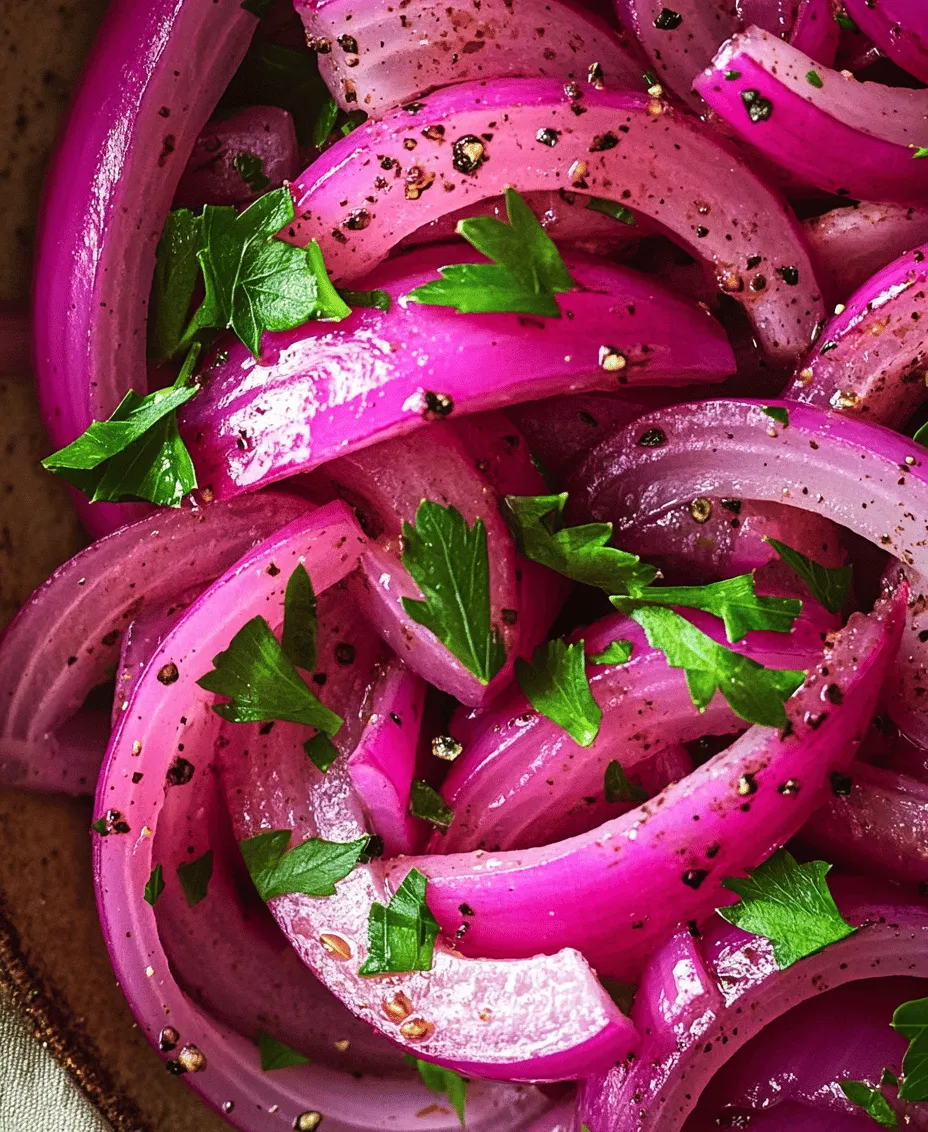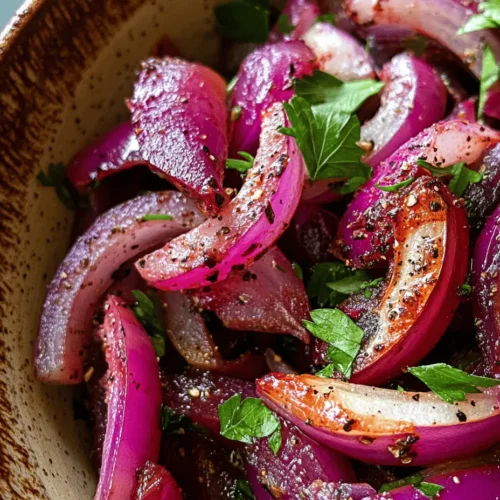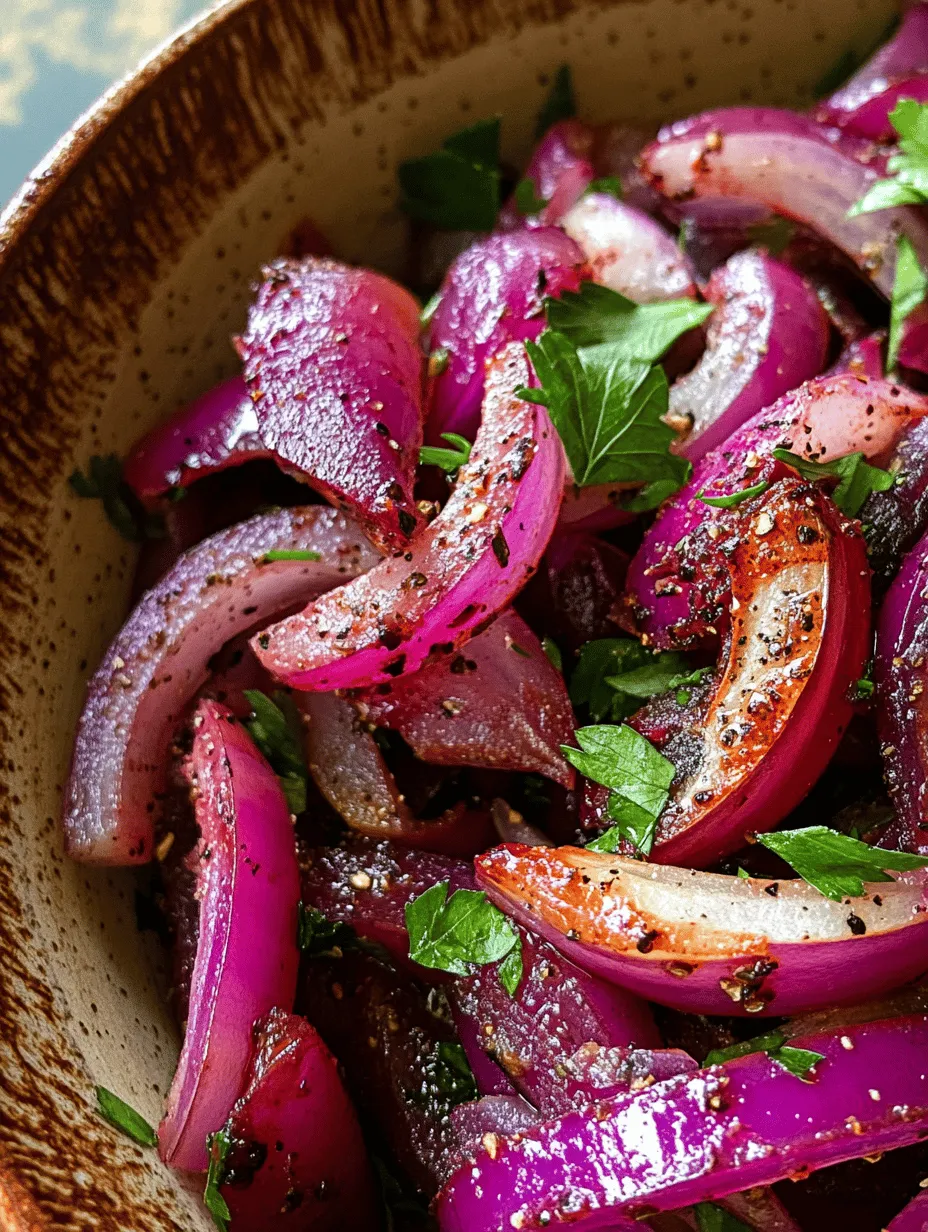Introduction
Sumac onions are a delightful side dish that brings a burst of flavor and color to any meal. Originating from Middle Eastern cuisine, this dish has gained popularity not only for its unique taste but also for its versatility. Sumac, a tart and tangy spice made from the dried berries of the sumac plant, pairs beautifully with the sharpness of onions, creating a balance that enhances a variety of dishes. This recipe is a celebration of simplicity and freshness, making it a favorite among those seeking quick yet impressive accompaniments to their meals.
The main ingredients in sumac onions—red onions and sumac—offer not only flavor but also numerous health benefits. Red onions are known for their antioxidant properties, while sumac is rich in vitamin C and has anti-inflammatory effects. Together, these ingredients create a dish that is not just delicious but also nutritious. Whether served alongside grilled meats, atop salads, or as a centerpiece in a mezze platter, sumac onions add a vibrant touch to any culinary creation.
Understanding Sumac: The Star Ingredient
Sumac is the key ingredient that elevates this dish and gives it its distinctive character. This spice has a long history in Middle Eastern cooking, where it has been used for centuries to add a zesty flavor to various dishes. Sumac is made from the dried and ground berries of the sumac plant, which grows in subtropical and temperate regions globally. It has a deep, reddish-purple hue and offers a tangy flavor reminiscent of lemon or vinegar, making it a perfect alternative to these more acidic ingredients.
Nutritionally, sumac is a powerhouse. It is rich in antioxidants, particularly flavonoids, which help combat oxidative stress in the body. Additionally, sumac contains beneficial compounds such as tannins and polyphenols, which are known for their anti-inflammatory properties. This spice is not only delicious but also contributes to overall health, making it a valuable addition to your spice cabinet. In culinary applications, sumac is incredibly versatile; it can be sprinkled over salads, mixed into marinades, or used to season meats and vegetables.
When compared to other common spices, sumac stands out for its unique flavor profile. Unlike spices such as cumin or paprika, which provide warmth and depth, sumac adds a refreshing tang that can brighten up rich or heavy dishes. Its ability to enhance flavors without overwhelming them makes it an essential ingredient in many Mediterranean and Middle Eastern recipes.
The Role of Onions in Cooking
Onions play a crucial role in cooking, serving as a foundational ingredient in countless dishes across various cuisines. Among the different types of onions, red onions are particularly favored for their vibrant color and slightly sweet flavor. When cooked or marinated, they develop a milder taste, making them an excellent choice for salads and garnishes.
Nutritionally, red onions offer a wealth of health benefits. They are rich in antioxidants, particularly quercetin, which has been shown to support heart health and reduce inflammation. Additionally, red onions contain vitamins C and B6, along with minerals like manganese and potassium. These nutrients contribute to overall well-being, making onions a staple in a balanced diet.
Different types of onions can be used in cooking, each bringing its unique flavor and texture. For example, yellow onions are commonly used in soups and stews due to their sweetness when caramelized, while white onions are often utilized in salsas and salads for their crispness. Red onions, however, stand out for their visual appeal and tangy flavor, making them perfect for dishes like sumac onions.
When incorporated into recipes, onions enhance not only the flavor but also the texture of dishes. They provide a natural sweetness that balances savory components and can transform a simple dish into something extraordinary. In sumac onions, the crunchiness and sharpness of the red onions complement the tangy sumac, creating a harmonious blend that excites the palate.
Ingredients Breakdown
To prepare sumac onions, you will need the following ingredients:
– Red Onions: The star of the dish, red onions provide a sharp yet sweet flavor that mellows when mixed with sumac. They add a crunchy texture and a beautiful pop of color, making the dish visually appealing.
– Sumac: This tangy spice is essential for the recipe. It adds a citrusy note that brightens the flavor of the onions and balances their natural sweetness.
– Olive Oil: A drizzle of high-quality olive oil not only helps to soften the onions but also enhances the overall flavor profile. Olive oil is rich in healthy fats and adds a subtle richness to the dish.
– Salt: A pinch of salt is crucial for bringing out the flavors of the onions and sumac. It enhances the taste and helps to balance the acidity of the sumac.
– Fresh Parsley: While optional, finely chopped fresh parsley adds a fresh, herbal note that complements the tartness of the sumac and the crispness of the onions. It also adds a vibrant green color to the dish.
Using fresh ingredients is vital for achieving optimal flavor in sumac onions. Fresh red onions have a crisp texture and sharpness that dried or older onions lack. Similarly, high-quality sumac ensures that the tangy flavor shines through. If you are looking for substitutions, consider using yellow onions for a sweeter flavor or even shallots for a milder taste. For those who prefer a milder flavor profile, soaking the onions in cold water for a few minutes before combining them with the other ingredients can help tone down their sharpness.
Preparation Process
Creating sumac onions is a straightforward process that requires minimal time and effort. Here’s a step-by-step guide to preparing this vibrant side dish:
1. Slice the Onions: Begin by peeling the red onions and slicing them thinly. Aim for even slices to ensure uniform distribution of flavor. Thinner slices will also soften faster when mixed with the other ingredients.
2. Combine Ingredients: In a medium-sized mixing bowl, combine the sliced onions with a generous sprinkle of sumac. The amount of sumac can be adjusted based on personal preference; start with about one to two tablespoons and taste as you go. Drizzle in some high-quality olive oil and add a pinch of salt.
3. Mix Thoroughly: Using your hands or a spatula, gently toss the onions with the sumac, olive oil, and salt until all the slices are well-coated. This step is crucial, as it allows the flavors to meld together, ensuring that every bite is flavorful.
4. Let it Marinate: For the best results, let the mixture sit for at least 15 to 30 minutes before serving. This resting period allows the onions to soften slightly and absorb the tangy flavor of the sumac. If you have time, marinating for a few hours or even overnight in the refrigerator will deepen the flavors even further.
5. Garnish and Serve: Just before serving, if desired, sprinkle some finely chopped fresh parsley over the top for added color and freshness. Serve the sumac onions as a side dish with grilled meats, as a topping for flatbreads, or as part of a mezze platter alongside hummus and tabbouleh.
By following these simple steps, you can create a beautiful and flavorful dish that is sure to impress your family and friends. With its bright colors and zesty taste, sumac onions are not only easy to prepare but also a versatile addition to any meal.

Importance of Salting the Onions and Its Role in the Marination Process
Salting the onions is a crucial step in the preparation of sumac onions, as it serves multiple purposes that enhance both texture and flavor. When you sprinkle salt over sliced onions, it draws out excess moisture through osmosis, resulting in a softened texture that makes them more palatable. This process also helps to reduce the sharpness of raw onions, mellowing their pungent flavor while allowing the other ingredients to shine through.
The salting process initiates the marination of the onions, allowing them to absorb the vibrant flavors of sumac and any accompanying seasonings. As the salt penetrates the onion layers, it creates a brined effect that infuses the onions with flavor, ultimately leading to a more balanced and harmonious dish. As a general rule, let the salted onions sit for at least 15–30 minutes before proceeding to the next steps, ensuring that they have adequately released their moisture and absorbed the seasonings.
Techniques for Slicing Onions Thinly for Even Flavor Distribution
The key to achieving perfectly marinated sumac onions lies in the technique used for slicing them. Thin, uniform slices allow for even marination and ensure that every bite is packed with flavor. Here are some techniques to help you slice onions thinly:
1. Use a Sharp Knife: A sharp knife will glide through the onion with precision, reducing the likelihood of crushing the onion cells which can release more pungent compounds.
2. Cut from Root to Tip: Begin by cutting off the top of the onion, leaving the root intact. This method helps keep the layers together as you slice.
3. Create Half-Moons or Rings: Depending on your preference, you can slice the onion into half-moons or rings. For half-moons, cut the onion in half through the root, then make thin slices perpendicular to the root. For rings, slice the onion crosswise into thin circles.
4. Use a Mandoline: If you desire precision and consistency, a mandoline slicer can provide perfectly thin slices without much effort.
Regardless of the method chosen, aim for slices that are about 1/8 inch thick. This thickness ensures that the onions marinate effectively and maintain a pleasant crunch.
Tips for Marination Time and Its Effect on Flavor Development
The marination time for sumac onions directly affects their flavor and texture. Here are some tips to consider:
– Minimum Time: Allow the onions to marinate for at least 30 minutes. This time frame is crucial for the salt to draw out moisture and for the sumac to impart its tangy flavor.
– Maximum Flavor: For deeper flavor development, marinate the onions for 2–4 hours. If time permits, let them sit in the refrigerator overnight. This longer marination allows the flavors to meld and intensify.
– Taste Test: After the initial marination period, taste a slice. If you find the flavor too sharp, let them marinate longer. If it tastes too salty, rinse the onions briefly under cold water and drain well.
– Stir Occasionally: If you are marinating for an extended period, give the onions a gentle stir every hour to redistribute the flavors evenly.
Flavor Profile and Pairing Suggestions
The combination of sumac and onions creates a delightful balance of flavors that can elevate various dishes. The tartness of sumac complements the sharpness of the onions, while the salt enhances these flavors, creating a deliciously complex taste profile.
Ideal Food Pairings
1. Grilled Meats: Sumac onions are a perfect accompaniment to grilled meats, such as chicken, lamb, or beef. The acidity of the onions cuts through the richness of the meat, providing a refreshing contrast.
2. Salads: Add sumac onions to mixed greens or grain salads to infuse them with a zesty flavor. They pair especially well with ingredients like feta cheese, olives, and cucumbers.
3. Flatbreads: Serve sumac onions atop warm flatbreads, such as pita or naan, for a simple yet flavorful appetizer. Drizzle with olive oil and sprinkle with additional sumac for a touch of elegance.
Creative Serving Suggestions for Different Occasions
– Picnics: Pack sumac onions in a jar as part of a picnic spread, providing a vibrant topping for sandwiches and wraps.
– Barbecues: Serve alongside grilled meats as a refreshing side, allowing your guests to customize their plates.
– Dinner Parties: Present sumac onions on a charcuterie board with assorted cheeses, cured meats, and olives for a sophisticated touch.
Health Benefits of Sumac Onions
Incorporating sumac onions into your meals not only enhances flavor but also offers several health benefits associated with both sumac and onions.
– Nutrient-Rich Ingredients: Onions are rich in vitamins C and B6, folate, and minerals like potassium. They also contain flavonoids, which are antioxidants that help combat oxidative stress in the body.
– Antioxidant Properties: Sumac is known for its antioxidant properties, which can help reduce inflammation and promote overall health. The anthocyanins found in sumac have been linked to various health benefits, including improved heart health.
– Weight Management: Sumac onions can fit into a balanced diet, providing flavor without adding excessive calories. Their low-calorie nature makes them an excellent choice for those looking to manage their weight while enjoying delicious food.
Cultural Variations of Onion Salads
Onion salads are a staple in many cuisines around the world, each offering a unique twist on this simple dish. Exploring these variations can inspire you to adapt the sumac onion recipe to suit your taste preferences.
– Middle Eastern Cuisine: In many Middle Eastern countries, onion salads often feature a base of tomatoes, cucumbers, and herbs, tossed with olive oil and lemon juice for a refreshing taste. The addition of pomegranate seeds can provide a sweet contrast to the tangy onions.
– Mexican Cuisine: In Mexico, pickled onions are commonly used as a condiment for tacos and other dishes. Marinating onions in lime juice, vinegar, and spices creates a zesty topping that complements rich flavors.
– Indian Cuisine: Indian onion salad, known as “kachumber,” typically includes diced onions, tomatoes, and cucumbers with a sprinkle of lemon juice and chaat masala. This dish adds a crunchy, refreshing element to spicy Indian meals.
Conclusion
Sumac onions are not only a flavorful addition to your culinary repertoire but also a versatile ingredient that can enhance a variety of dishes. With their balanced combination of acidity, saltiness, and earthiness, they provide a refreshing contrast to richer foods and can elevate any meal.
As you experiment with this simple recipe, don’t hesitate to play with flavors and adapt the dish to your liking. Incorporating vibrant ingredients like sumac and onions into your everyday meals can transform your dining experience, making it both exciting and health-conscious. So, gather your ingredients, slice those onions with skill, and enjoy the delightful burst of flavors that sumac onions can bring to your table.



